
The image of the cholita has preoccupied Bolivia for decades—sometimes reviled but, recently, renowned. The archetypical cholita is a short, middle-aged woman wearing a long dress with petticoats, a shawl, and an emblematic bowler cap atop her thickly braided hair. She chews on coca leaves and sometimes sells them in small plastic bags. She is often seen waiting for buses to and from the Andean countryside, shouldering an absurdly large bundle on her compact frame. If cholitas are taken to signify an actual demographic group, it is Bolivia’s rural poor, who for centuries have kept indigenous languages alive and traded between towns and villages while maintaining a distinguishing country aesthetic. To urban Bolivians, their bowler hats and braids seem to proclaim that cholitas —despite their frequent contact with cities—have not forgotten where they truly come from. Yet these women and their families have lived in informal urban settlements for generations, often suffering everything from official neglect to acts of outright racism.
The lives of cholitas changed dramatically with the election of Evo Morales in 2006, along with their neighborhoods—usually vast, high-altitude slums, which are now slowly being fitted with better transportation and public services. The “Evo Era” brought a populist-socialist revolution to Bolivia led by the indigenous poor. Yet, it has also produced some unplanned and, perhaps unwanted, symbols of the newly empowered poor: a new, instantly recognizable residential typology for the emerging indigenous middle class. Perched high above informal urban settlements in La Paz and other Bolivian cities, these houses burst forth from their utilitarian environments in rococo Technicolor. Their most visible instance is in El Alto, the sprawling sister of La Paz, which began as an informal settlement but has since outgrown the capital, spreading upward into the hills in a jumble of half-finished homes and markets where plumbing supplies are sold for the ongoing construction boom. They have been dubbed cholets—the “chalets” of the cholitas.
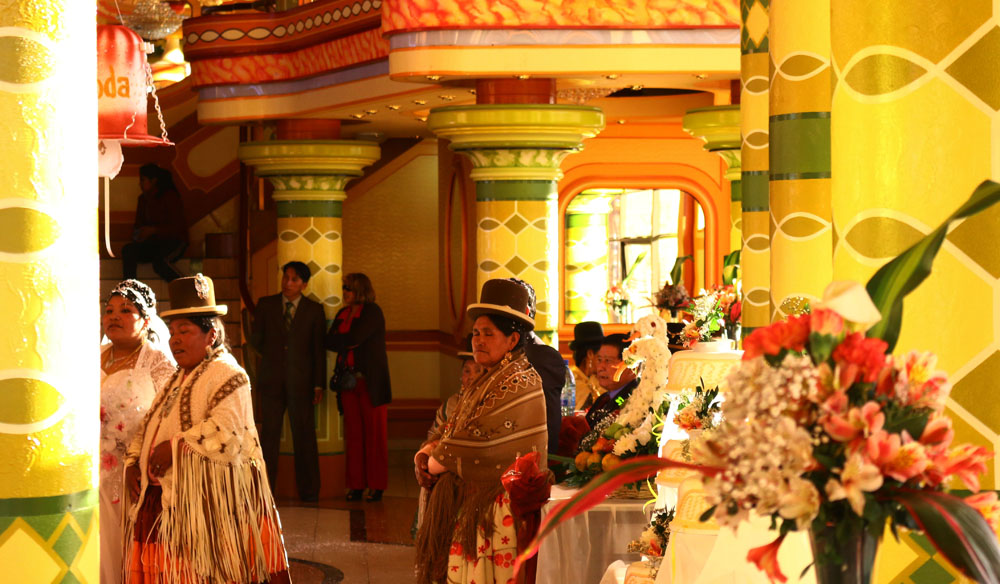
For much of the history of modern Bolivia, cholitas were viewed either as a source of ridicule or fascination. For detractors, they bore all the hallmarks of a country stuck in time. Their outfits were considered provincial, they often spoke in Aymara instead of Spanish, and they chewed coca leaves and drank homemade corn beer called chicha. While indigenous men could don futból jerseys and jeans when they came to cities, women were sometimes expected to maintain traditional attire or they chose it as a form of cultural resistance. More recently, cholitas have also provided entertainment for gawking tourists, who would pay to watch women in cholita garments fight in lucha libre rings along with spandex-clad, mask-wearing men wielding folding chairs.1
The election of Evo Morales, the first indigenous president of Bolivia, has ushered in a uniquely different cultural and political climate in the small landlocked nation, most notably through his commitment to a Latin American variant of socialism championed by the late Hugo Chávez. Morales, once a union representative for coca farmers, has pursued policies that assist the rural indigenous poor, many of whom are quickly moving to cities.2 On the campaign trail, Morales spoke clearly and forcefully about the need to restore pride in Bolivia’s pre-Columbian past. He stated that after decades of denial, it was time for Bolivians to recognize the fact that they were the most indigenous country in South America, yet ruled by a European political class.3 When Morales took office in 2006 he made a point of wearing colorful, traditional Andean clothing to international summits. He also changed the country’s official name to the “Plurinational State of Bolivia.” With this injection of pride for the country’s indigenous origins came a correspondent boost in the public regard and fortunes of cholitas, nearly all of whom are avid Evo supporters.4
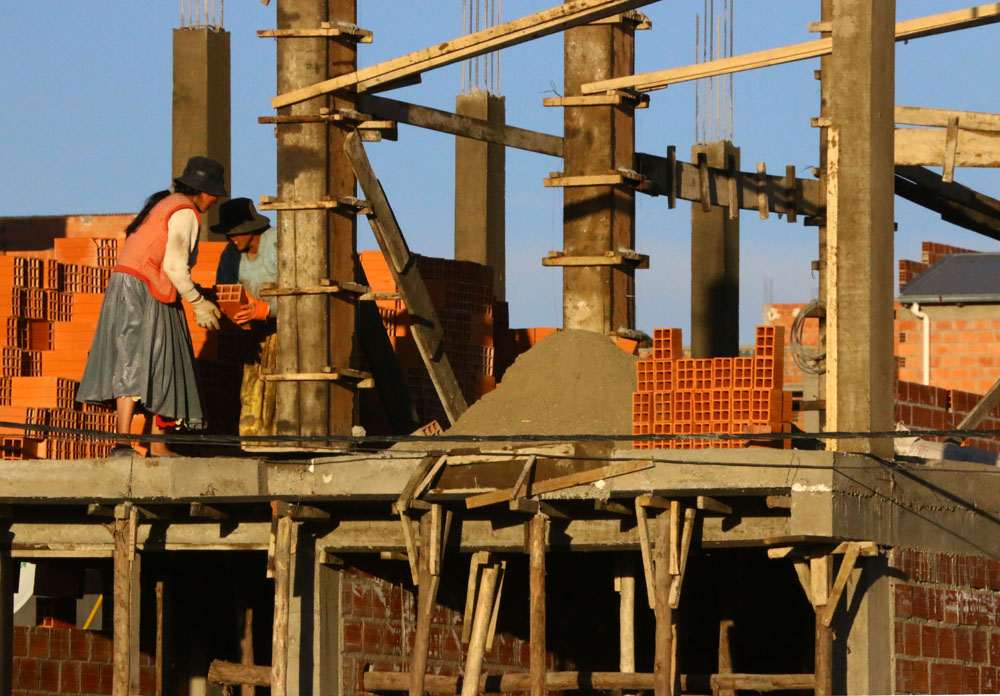
Mansions, Shacks, and the Informal Urbanism of El Alto
The profusion of cholets indicates a shared desire among Bolivia’s newly empowered lower middle class—which should perhaps be referred to as the “cholita class,” as ethnic background is at least as significant to its construction as economic status—to build homes commensurate with their new station in society. The construction of cholets also signals the permanence of unplanned urbanism in La Paz and the intention of formerly rural Bolivians from indigenous backgrounds to make the capital home. The houses, whose envelopes combine a mixture of columns, arches, and colored glass, sprawl out and hover over quickly built brick and corrugated metal structures. Unlike the stereotypical suburban mansions, cholets are not bounded by large estates but rather are attached and midrise: they often look more like a mini shopping mall than a home. Perhaps unsurprisingly, they are frequently designed by their owners, though some are executed by young architects who specialize in the type, many of whom also come from humble indigenous backgrounds. The buildings utilize colorful exterior murals that are reminiscent of Andean tapestries or shawls worn by cholitas. Inside, they resemble exuberant Bolivian wedding halls and are often used to entertain extended family. Some resemble mini Moorish castles domed with Miami-style blue glass. Others are so immense that they double as commercial spaces that can be rented out for quinceañeras. Many of the homes are, as “cholet” suggests, owned and managed by women as a business, house, and family gathering place—demonstrating the more entrepreneurial role of some women in a culture quickly changing due to city life. All are given grand names, often with a formal nod to Bolivian geography—Illampu (after a Bolivian peak, meaning “the strongest” in Aymara), The Titanic, and El Diablo.
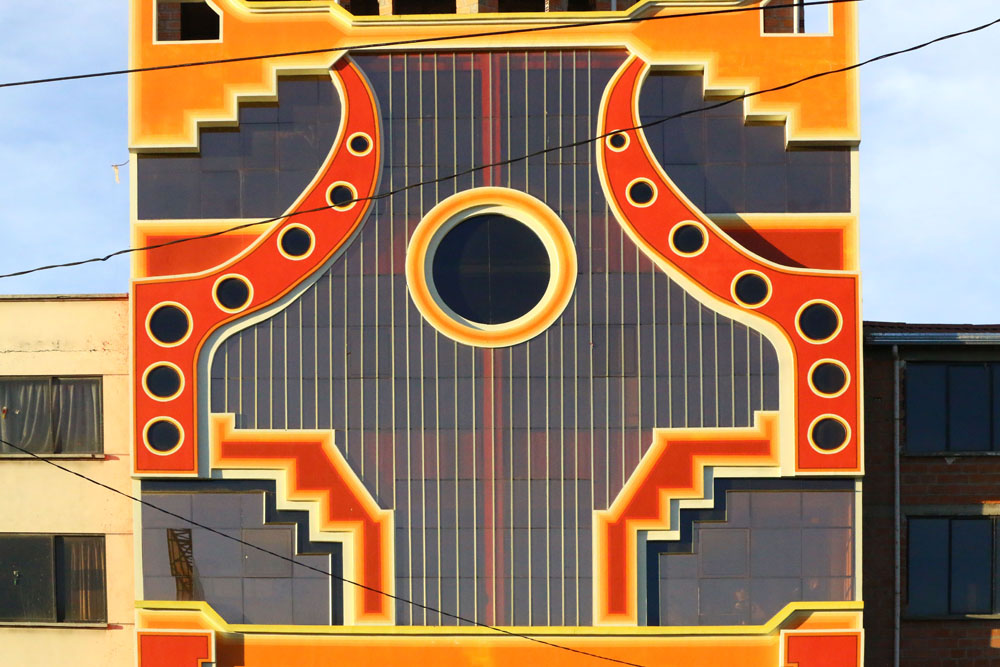
Some of Bolivia’s middle-class professionals have been made uncomfortable by these new mansions’ liberal use of color and expensive materials like chandeliers and colored glass, as well as their sheer size. They feel that the country can go its own way politically, but it must at least try to conform to the aesthetics of other larger Latin American cities that strive for a toned-down modernist aesthetic of corporate black glass and steel buildings interspersed with concrete apartment blocks. Like all political movements that emphasize class equality, Morales’s Movimiento al Socialismo Party frowns upon conspicuous consumption, and such a bold display of material wealth in private rather than public architecture is considered an even worse ideological violation. Nevertheless, younger Bolivian architects have been happy to build cholets. Although they fret that the aesthetic they broadcast might be a bit too loud, they appreciate the upsurge in architectural populism.5 Some architects commented that they find the cholets to be uniquely Bolivian and a refreshing jolt for design in a nation in which commissions were previously dominated by recycled versions of whatever was in vogue in Miami, Mexico City, or Buenos Aires. Architects also see the outflow of creative energies in poor neighborhoods as a positive sign that their profession may have a more egalitarian future in Bolivia, serving a larger variety of class and ethnic groups. The king of cholet construction, interviewed for this article and for many other foreign media outlets, is Freddy Mamani, who is largely self-taught and comes from modest Aymara roots. Spurred by his father’s job as a bricklayer to start building homes, he is now a minor celebrity among the new middle class of El Alto and often pops into events in the cholets he designed to be warmly welcomed by the celebrants. In most cases of cholet construction, however, clients communicate their vision of their dream home directly to an army of contractors, builders, masons, and plumbers. Thus, the informality of urban settlements like El Alto is seen in a generation of middle-class homeowners who are comfortable with “Do-It-Yourself” design and architecture because their parents’ generation built an entire city—with more than half a million residents—in the same fashion.
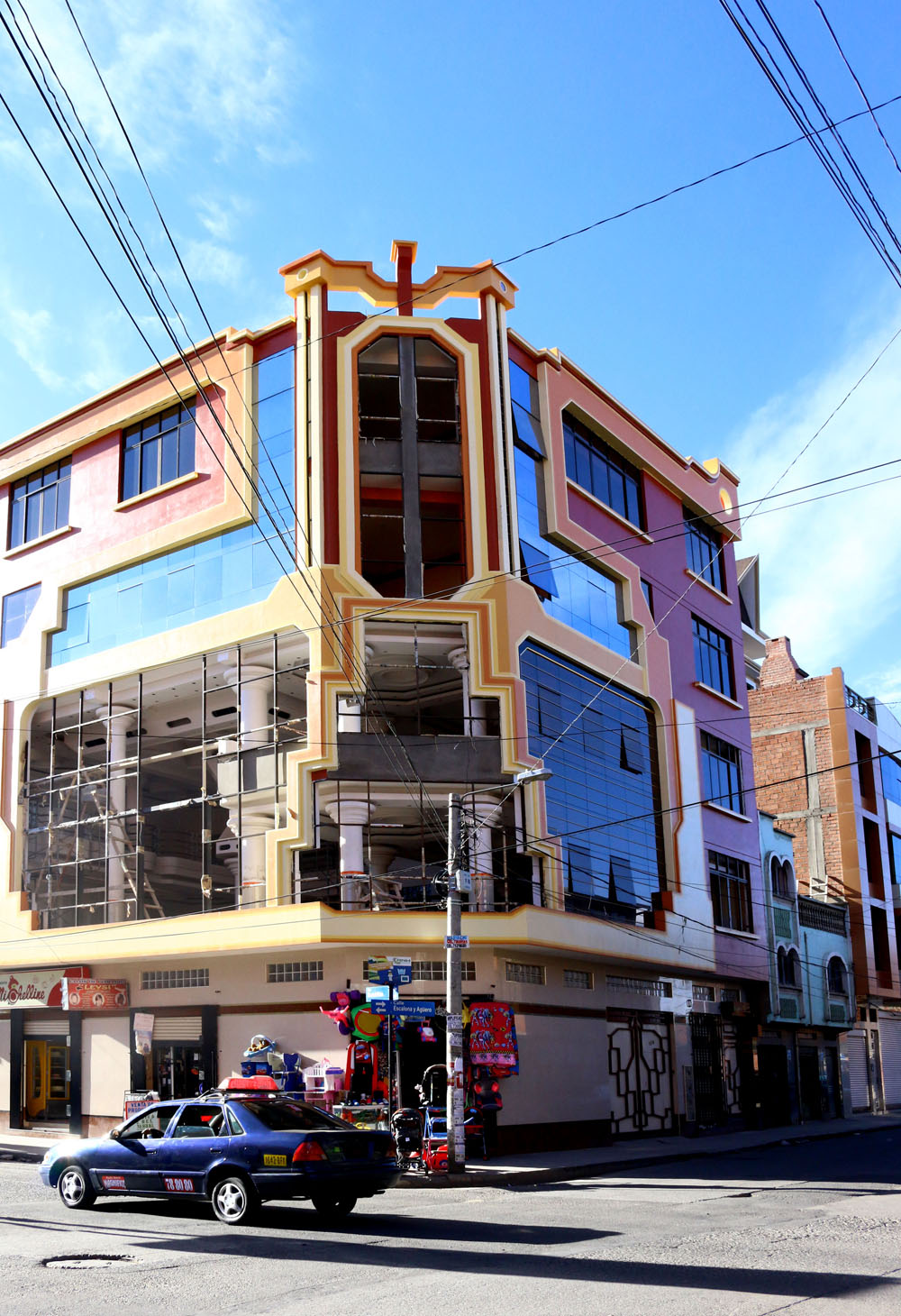
The “Pink Tide” of Andean Urbanism
The question of how to gently retweak the aesthetic proclivities of one’s political power base has been a perpetual problem for revolutionary political regimes. Historically, it has been important to both separate new political movements from the architecture of their predecessors while also steering these new movements away from the aesthetic vocabulary of competing regional and global powers. After the October Revolution in 1917, there was a period of artistic exuberance and copious output in an attempt to find a “truly socialist style” before the heavy hand of Stalinism squeezed the cultural sphere into absolute compliance.6 More democratic political regimes have also struggled to create a style that both heralds a new era while avoiding any artists whose work is so iconoclastic that they might erode support by directly challenging the more traditional sensibilities of the political base. Diego Rivera, for example, is a good example of someone who was more risk than asset to the engineers of the New Deal’s distinctive aesthetic identity, which was normally executed and promoted by more “compliant” artists and artisans. One of the major questions facing contemporary Bolivian architecture is how to go about fulfilling the popular desire to step away from the American-dominated language of subtle-yet-elegant postmodernism. South American leaders like Morales would eventually like to embrace something of an architecture that rejects US tastes as an extension of South America’s renouncement of the United States’ economic agenda. In many ways, it is easier to distance national culture from US hegemony rather than disentangle an entire globalized economic system. Yet, many Evo followers are divided as to whether cholets fulfill the mission of stylistic autonomy or whether they simply embrace the North American dream of opulence and abundance by using a South American visual vocabulary, a question currently dividing many Evo followers.
In Bolivia, private property itself has been a contentious issue in recent years. In 2000, social conflict erupted in the city of Cochabamba over water privatization plans that would have drastically affected the urban poor. The ensuing insurrection, in what has come to be known as the Water War, forced the hand of the pre-Morales government to back away from privatization plans for water and other public utilities.7 This conflict created a strong urban activist class who complemented Morales’s rural base and eventually proved pivotal to electing him and keeping him in office. This class is sometimes at odds with poorer and more rural members of the Morales coalition, and the two groups are quite likely to have divergent views on cholets. Recently urbanized and newly prosperous Morales supporters are inclined to appreciate them as signs of success and the ascendance of people whose life stories mimic their own. Intellectual leftists, born and raised in cities, have a different taste culture— one that often separates them from rurality and condemns the architectural exuberance of cholets as tacky and gauche. For those well-versed in the socialist logic that supports the “pink tide” of the Latin American Left, large, conspicuous homes are not only a symptom of poor taste but an act of deviation from revolutionary principles as well as a disloyal embrace of American materialism and fetishism for all things glittery.8

One of the greatest problems with opulence in Bolivia is that for as long as most Bolivians can remember, middle-class life was something that happened elsewhere. You could find it on TV—when watching American shows or telenovelas in which the pale actors bore no resemblance to the average Bolivian. You could locate it in the cities of Argentina or Chile, where Bolivians earn money to send home. But you certainly could not find it in most of the country’s cities. There were two groups with wealth: the elite class—who were assumed to have participated in all manner of deviance, including embezzlement and collusion with foreign companies in order to get their money—and drug traffickers. The idea of people with honestly attained income of an amount that could allow for a dramatic house—a house that represented the pride of the entire family—was almost unheard of. Today, however, due to new jobs programs and an improvement in small-business ownership, this situation is no longer difficult to imagine. Cholets are starting to create a kind of upstart confidence among those who live in the neighborhoods where they have recently been built. While they are not technically a public good (which is almost nonexistent in El Alto), their mere placement on the map has created a sense of pride in quickly built cities like El Alto, where, previously, necessity and utility were everything.
The French sociologist Pierre Bourdieu was the grand interpreter of taste as a class symbol. Raised in postwar France, where the opera and string quartets of the old guard were rapidly being replaced by the futból matches and steak frites of the parvenus, he wrote his magnum opus Distinction to show how people’s “natural preferences” were anything but organic.9 Instead, Bourdieu argued, “taste culture” is a sprawling system of semiotic clues about one’s class and social position that we can interpret through our own immersion in the same system. Architecture has always played only a modest role in this schema because most people don’t have access to the field. Particularly in the developing world, it is still a non-profession.10 Builders are usually easy to find, and some of them may well call themselves architects, but individuals with an education and training in an autonomous and rigorous profession that emphasizes design over construction are often far less accessible. This has opened up some very interesting possibilities and, of course, also created a lot of places like El Alto, in which a lack of institutional support and oversight of design, planning, and construction creates zero planning, zero foresight, and almost no regulation.11 The democratic nature of architecture in places like Bolivia has made the relationship between cholita and cholet more direct than it would be in a more prosperous country. This process scares many Bolivian public officials concerned with construction, because quality is dubious and safety procedures mostly absent. It also frightens those who want Bolivian cities to develop in concert with an aesthetic framework that more closely resembles that of wealthier South American countries, like Argentina or Chile, where architecture is professionalized. Cholets are officially celebrated as horizontalist—following the properly socialist tradition of bottom-up decision making—but are also privately dreaded. Horizontalidad allows for individuals to buck the official cultural dogma of those in power and the cholet provides a site where these conflicting ideological concerns play out in Technicolor. Meanwhile, the cholitas continue to try out new dreams.
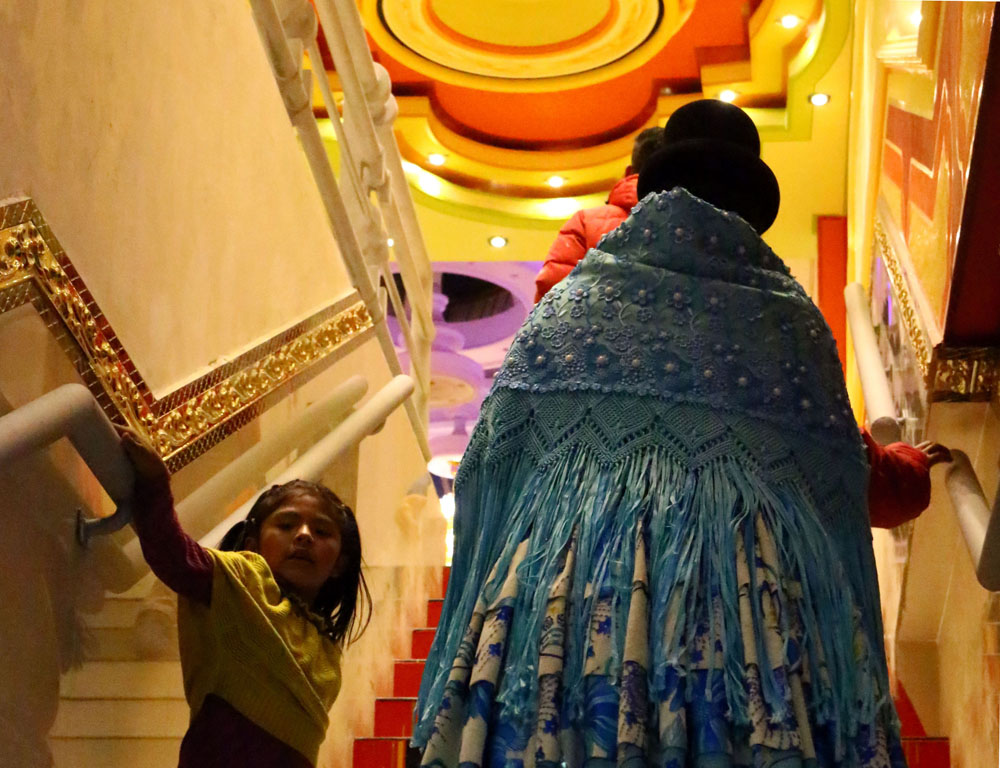
The research for this piece was conducted collaboratively by Max Holleran and Pedro Rodríguez García.
-
Before the victory of Evo Morales, Bolivia was a classic example of patronage politics, in which indigenous groups received some services in exchange for supporting candidates who were of European descent and based in cities. Unfortunately, Bolivia, like many other countries in the region, also has a history of military-political networks that used the coup as a standby in their political toolkit. These regimes were often supported by the US government for their anti-communist credentials but were frequently little more than graft networks for military and political leaders. One of the most notable examples was Colonel Hugo Banzer Suárez, who was installed as chief of the military junta in the 1980s and, in a strange testament to the former instability of Bolivian politics, was democratically elected in the 1990s as a force for political and economic stability. See Benjamin Kohl, “Restructuring Citizenship in Bolivia: El Plan de Todos,” International Journal of Urban and Regional Research, vol. 27, no. 2 (2003): 337–51. For more on cholita lucha libre, see Johnny Langenheim, “Bolivia’s female wrestlers: ringing the changes,” The Guardian, November 2, 2012, link. ↩
-
For more on the urban-rural coalition of Evo Morales’s Movement for Socialism Party, see Santiago Anria, “Social Movements, Party Organization, and Populism: Insights from the Bolivian MAS,” Latin American Politics and Society, vol. 55, no. 3 (2013): 19–46. ↩
-
See anthropologist Nancy Grey Postero’s book Now We Are Citizens: Indigenous Politics in Postmulticultural Bolivia (Palo Alto: Stanford University Press, 2007) for a better understanding of both the fight for indigenous rights in the lead-up to the election of Evo Morales. ↩
-
Jenny Cartagena Torrico, “Bolivian women are breaking down barriers to seek political power,” The Guardian, August 6, 2012, link. ↩
-
“Con la nueva burguesía aymara nace en Bolivia la arquitectura ‘neoandina,’” La Jornada, May 23, 2014, link. ↩
-
Svetlana Boym, Architecture of the Off-Modern (New York: Princeton Architectural Press, 2008). ↩
-
Nina Laurie, “Gender Water Networks: Femininity and Masculinity in Water Politics in Bolivia,” International Journal of Urban and Regional Research, vol. 35, no. 1 (January 2011): 172–88. ↩
-
Many political scientists have argued the recent “left turn” in South American politics is due not only to intensified rhetoric against traditional elites but also to new forms of organizing that have, through a grassroots structure, attracted the perpetually marginalized. Thus, cholets symbolize the quick economic ascent of some of the very poor, and the prospect of a newly enriched and powerful lower middle class. For a summary of the political base of the new Latin American Left, see Mike Geddes, “Neoliberalism and Local Governance: Radical Developments in Latin America,” Urban Studies, vol. 51, no. 15 (November 2014): 1–17. ↩
-
Pierre Bourdieu, Distinction: A Social Critique of the Judgement of Taste (Cambridge, MA: Harvard University Press, 1984). ↩
-
Cynthia E. Smith, “Design with the Other 90 Percent: Cities,” Places Journal (October 2011), link. ↩
-
See Teddy Cruz’s notable work on “Third World Urbanism” and the need for developed cities to learn from urban informality and the patterns that rise out of regulatory chaos. Most recently, “Spatializing Citizenship and the Informal Public” in Territories of Poverty: Rethinking North and South, eds. Ananya Roy and Emma Shaw Crane (Athens, GA: University of Georgia Press, 2015). ↩
Max Holleran is a doctoral candidate in urban sociology at New York University.
Pedro Rodríguez García is an artist and educator based in Cochabamba, Bolivia.

